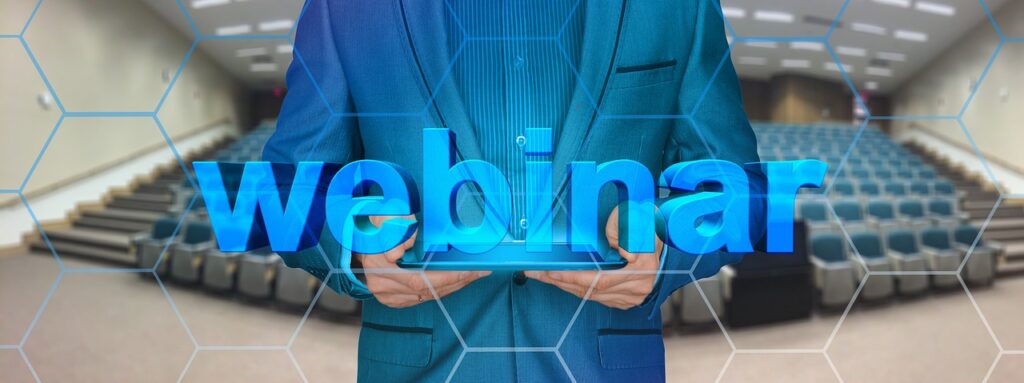In the evolving landscape of digital communication, webinars have emerged as a cornerstone for businesses, educators, and entrepreneurs. They bridge geographical divides, fostering an environment of learning, sharing, and interaction. However, as the digital space becomes increasingly saturated, capturing and maintaining audience attention is a challenge that cannot be ignored. Herein lies the pivotal role of gamification in enhancing audience interaction during webinars.
Gamification entails the integration of game mechanics into non-gaming environments to boost user engagement, participation, and loyalty. It’s an art of leveraging human psychological predispositions to engage and motivates. In the context of webinars, gamification transforms the static experience of listening and viewing into a dynamic interaction, making the audience an integral part of the content narrative.
The Psychological Underpinning
Humans are naturally inclined towards elements of play, competition, achievement, and recognition. These are the foundational stones upon which games are built. Gamification in webinars taps into these intrinsic motivators, elevating the user experience from passive receipt of information to active participation. It crafts an immersive environment where learning and interaction are seamlessly intertwined, resulting in enhanced content retention, active participation, and a deeper connection with the content and presenter.
The Multifaceted Benefits
In the intricate dance of audience engagement, gamification injects an element of fun and competition. Polls, quizzes, and interactive challenges foster a sense of community among attendees. They’re not just passive spectators but active contributors to the content narrative. This not only amplifies engagement but also aids in real-time content customization, with presenters adapting and responding to live audience feedback.
A Dynamic Audience Experience
Imagine a webinar where every slide, every piece of content is a pathway to interaction. Where polls unravel audience insights in real-time, challenges ignite the competitive spirit, and interactive Q&As transform audience queries into a collective knowledge pool. Every attendee, whether they’re a thousand miles away or in the next city, is a part of a unified, interactive digital ecosystem.
Customization and Personalization
At the heart of successful gamification lies the principle of customization. Each audience is unique, each webinar a distinct narrative. Gamification tools and strategies should be meticulously aligned with the content, audience demographics, and webinar objectives. It’s not a one-size-fits-all but a tailored approach, where game mechanics are intricately woven into the content narrative, enriching the audience experience while amplifying content engagement and retention.
Strategies for Effective Gamification
As we delve deeper, it becomes pivotal to understand the strategies that can make gamification an integral part of the webinar experience, rather than an add-on.
Align with Objectives
Every game element introduced should be in harmony with the overarching objectives of the webinar. It should amplify the core message, fostering an environment where learning and engagement go hand in hand. Points, badges, or leaderboards should not just be about winning but about learning, contributing, and engaging.
Balancing Act
Balance is key. While game elements can enhance engagement, overdoing it can lead to distraction. The focus should always be on the content. Gamification is a tool to amplify engagement, not overshadow the core content. The design should be intuitive, inviting attendees to participate without feeling overwhelmed.
Data-Driven Insights
One of the most uncharted territories of gamification is the rich data it provides. Every interaction, every click is a pathway to audience insights. Analyzing this data can provide a goldmine of information on audience preferences, knowledge gaps, and engagement patterns, shaping future content and strategies.
Evolution of Content
In a world powered by dynamic content, webinars need to evolve. Gamification fosters an environment of continuous feedback. It’s not just about the presenter speaking; it’s a two-way interaction. Content becomes fluid, adapting in real-time to audience responses, questions, and interactions. It’s a narrative crafted collectively, a journey of shared insights and learning.
Legal and Ethical Considerations
As with any engagement tool, there are legal and ethical considerations to be mindful of. Consent, privacy, and data security are paramount. Each game element, especially those collecting user data or responses, should adhere to stringent privacy and ethical norms.
The Psychological Paradigm
Diving further, it’s critical to recognize that the heart of effective gamification isn’t the technology or the fancy badges – it’s psychology. Understanding the psychological triggers that motivate attendees to participate, engage, and learn is foundational in creating a webinar that isn’t just seen but remembered and acted upon.
Intrinsic and Extrinsic Motivations
Two types of motivations drive human behavior – intrinsic and extrinsic. Intrinsic motivations are internal; people are driven by intrinsic satisfaction. In contrast, extrinsic motivations are external rewards like certificates, badges, or public recognition. The magic lies in balancing these two, creating a webinar where attendees are motivated intrinsically to participate and supplemented by extrinsic rewards that add tangible value.
The Mastery-Cliff Effect
One of the key psychological triggers in gamification is the Mastery-Cliff effect. Attendees are motivated by the drive to master a skill or knowledge. However, this motivation plummets if the content is either too easy or too difficult. Striking a balance, creating content that is engaging yet challenging, and integrating game elements that facilitate this balance is key.
Community and Collaboration
Human beings are social creatures. We crave community and collaboration. Gamification isn’t just about individual achievements but fostering a sense of community. Leaderboards, discussion forums, team challenges – these elements bring attendees together, creating a sense of community and collaboration that extends beyond the webinar.
Real-Time Feedback
Another psychological aspect is the power of real-time feedback. It’s not just about knowing the right answer but knowing it immediately. Real-time feedback, facilitated by game elements, amplifies the learning experience, creating a dynamic environment of continuous learning and improvement.
Customization to Individual Learning Paths
Every attendee is unique, bringing to the table diverse experiences, knowledge levels, and learning styles. The future of gamification lies in personalization – creating customized learning paths, integrating game elements that adapt in real-time to individual responses, ensuring every attendee is engaged, challenged, and motivated to explore further.

Related: Check out our free SEO suite

Augmented Reality (AR) in Webinar Engagement
As we continue our journey through the dynamics of webinar interactions, augmented reality (AR) emerges as a powerful tool that can significantly elevate the level of engagement. It provides an interactive experience of a real-world environment, where objects residing in the real world are enhanced by computer-generated perceptual information.
Overcoming the Digital Barrier
One of the perpetual challenges of webinars is the ‘digital barrier’. Attendees are separated by screens, often reducing the emotional and cognitive engagement. AR steps in as a bridge, integrating digital elements into the real world, making engagement immersive and interactive.
Real-Time Interactions
In a world driven by instant gratification, real-time interactions have become non-negotiable. AR facilitates this by allowing attendees to interact with the content, presenters, and even other attendees in real-time, creating an ecosystem of dynamic, real-time engagement.
Personalization Through AR
The ‘one-size-fits-all’ model is becoming obsolete. The modern attendee seeks personalization, content, and interactions that are tailored to their needs, interests, and learning pace. AR in webinars can be a game-changer, offering personalized experiences, custom-tailored content rendering, and interactions that adapt in real-time to the attendee’s responses.
Practical Applications
Imagine a financial webinar where attendees can interact in real-time with 3D models of statistical data, or a healthcare webinar where medical professionals can explore a 3D model of the human body, delving deep into complex concepts with real-time interactions facilitated by AR.
AR Analytics
Beyond engagement, AR provides a treasure trove of analytics. Every interaction, response, and engagement is data – offering insights into attendee behavior, preferences, and learning patterns. This data is gold for businesses, offering actionable insights for content optimization, targeted marketing, and personalized engagement.
Future Trends
As the technology continues to mature, the integration of AR in webinars is anticipated to become more streamlined, user-friendly, and accessible. We are stepping into an era where webinars are not just about seeing and hearing but about experiencing, interacting, and immersing – breaking the fourth wall of digital engagement.
Conclusion
The ever-evolving landscape of webinars is indicative of a digital era that continues to merge the technological with the human, the informational with the experiential. From the meticulous art of crafting compelling webinar titles to the intricate science of audio-visual optimization, every facet is geared towards a singular objective – enhanced engagement.
We’ve traversed through the multifaceted world of webinar interaction, shedding light on the profound impact of methodologies like gamification, the integration of AR, and the pivotal role of feedback. Audience segmentation stands as the unsung hero, ensuring that content resonates, interactions are personalized, and engagement is maximized. In the world of webinar funnels, every interaction, every piece of content, is strategically designed and placed to nurture leads, build relationships, and drive conversions. The webinar isn’t an isolated event but a pivotal touchpoint within a broader, more holistic customer journey.
READ NEXT:
- A Guide to Webinar Monetization Strategies
- How to Optimize Webinar Timing for Maximum Attendance
- SaaS Startups and SEO: Tailored Strategies for Software Companies
- The Impact of Webinar Recordings in Post-event Engagement
- Attribution Models for Financial Websites: Understand Your Customer Journey
- How to Optimize Webinar Audio and Visual Quality





















Comments are closed.